THE CLASSROOM
Fad or fountainhead?
by Katharine Davis Fishman
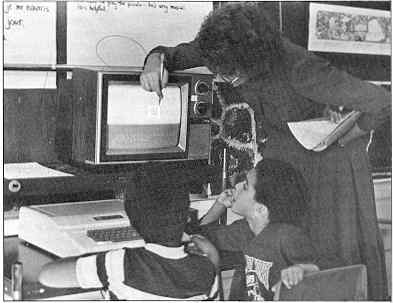
Students at Bank Street School learn about programming Logo sprites.
Katharine Davis Fishman is the author of The Computer Establishment. She writes on a variety of subjects for major magazines.
Within eight years of the introduction of the personal computer, according to a Johns Hopkins study, more than half the schools in the United States had bought at least one microcomputer to teach with. And today, the same study reveals, those elementary and secondary schools that bought computers for "drill-and-practice" or "tutorial" purposes are turning increasingly toward teaching children to program.
Computer people who tout the benefits of programming-most notably the advocates of the Logo language-argue that it teaches logic, planning and problem solving. Since these are all activities with powerful significance in intellectual development and in life itself, it's not surprising that, as one observer has written, "programming is viewed by many of its devotees as a Wheaties of the Mind."
But at what age do children begin to profit from programming? Can all children reap similar rewards? Is what's going on in the computer lab meaningful or is it all just fun and games?
Two Schools Observed
As part of a joint program with the New York Academy of Sciences and with the help of a National Science Foundation grant, several districts in the New York public school system have established Logo programming classes. District 3 on Manhattan's Upper West Side has what Tessa Harvey, who directs its Office of Funded Programs, calls "a moral and financial commitment to using computers in an educationally sound way." The philosophical issue behind this commitment, she says, is that "the haves get more and the have-nots get less. Rich kids and rich schools are going to have computers. We felt that in order not to widen the gap that already exists we have to make computers available to kids who would not otherwise have them."
Joan of Arc Junior High School
J. H. S. 118 on West 93 Street, better known as Joan of Arc, is a neighborhood institution of long standing whose population has changed according to familiar trends: today nearly half its students are black, 42 percent are Hispanic, and the remaining 10 percent are mostly white with a few Asians. In the spring of 1983 I visited the computer lab here, which housed eleven Apple IIs, five Atari 800s and a TI 99/4A, an endowment that many richer schools might envy. The magi of the computer program were Peter Rentof and Steve Siegelbaum, who oversaw something called the Environmental Cluster-comprising two classes of eighth- and ninth graders, sixty-five kids in all. Siegelbaum and Rentof feel that computer use is a powerful motivator. "We had a boy the first year who was severely dyslexic," says Siegelbaum, "until he began spending time at the computer during lunch hour. I noticed he had much less trouble with reversal of letters when he used the keyboard." The student became an expert of whom other kids could ask questions, which helped his selfimage tremendously. Soon he was volunteering to go to the blackboard and putting problems up and writing his name. Before this he wouldn't write at all.

Jennifer Nix' animated snowflakes.
Since the kids who do well at Logo programming are not necessarily the best students in the class, Logo can confer some status on underachievers. "If I give a test," Rentof says, "and a kid flunks or passes, that's different from when I come over and see him creating something with his own knowledge and I say, `How did you do that?' These projects are impressive to adults, and it shows, and the kids feel powerful in themselves."
Rentof feels that programming procedures have a particular resonance for these students. "Some kids come from homes in which there's very little logic to their lives," he notes. "Here they get a steady dose of logic: there's always a consequence for what you do." Still, it's not always possible to pinpoint the effects of programming on individual students or tell whether changes should be credited to the computer or to good instruction in regular math or, at this most volatile of ages, to ordinary growth. One boy who was flunking regular math used algebra capably in his Logo projects, and Siegelbaum says "he's becoming a crackerjack programmer. He's an interesting case, at his most disciplined when he's at the computer. We've yet to see whether this carries over into his other work."
On one visit to the lab I saw a graffito flickering in cheerful multicolored capitals on the screen of one of the Apples. It read:
PEOPLE ARE INSTINCTIVELY SCARED OF WHAT
THEY CAN'T COMPREHEND.
INDENT THAT'S ONE OF THE MAIN REASONS PEOPLE ARE RELUCTANT TO USE THE COMPUTERS. THEY ALSO HAVE TO OVERCOME THEIR FEAR OF MAKING ERRORS, AS APPARENTLY I HAVE MADE MANY.
INDENT PEOPLE TAKE ONE LOOK AT ME, THE WAY I DRESS, AND RIGHT AWAY JUDGE ME AS NOT HAVING ANY HIGHER INTELLECT THAN THE AVERAGE PUERTO RICAN ON THE STREET. ONCE YOU START TO UNDERSTAND THINGS THAT SEEM TO LOOK COMPLICATED, BUT WHICH CAN BECOME UNDERSTANDABLE, IF OF COURSE YOU APPLY YOURSELF TO IT, YOU HAVE A CHANCE.
INDENT THAT'S ONE OF THE MAIN REASONS PEOPLE ARE RELUCTANT TO USE THE COMPUTERS. THEY ALSO HAVE TO OVERCOME THEIR FEAR OF MAKING ERRORS, AS APPARENTLY I HAVE MADE MANY.
INDENT PEOPLE TAKE ONE LOOK AT ME, THE WAY I DRESS, AND RIGHT AWAY JUDGE ME AS NOT HAVING ANY HIGHER INTELLECT THAN THE AVERAGE PUERTO RICAN ON THE STREET. ONCE YOU START TO UNDERSTAND THINGS THAT SEEM TO LOOK COMPLICATED, BUT WHICH CAN BECOME UNDERSTANDABLE, IF OF COURSE YOU APPLY YOURSELF TO IT, YOU HAVE A CHANCE.
Across the room Jennifer Nix, one of the Cluster's computer stars, was running her animated cartoon. First snowflakes fell diagonally on the roof of a house and piled up on the ground. Then a stork flew down and deposited a baby in front of the house; stick figures of a mother and father came out and gathered up the baby; the snowflakes turned to hearts, and the caption appeared: AND THEY LIVED HAPPILY EVER AFTER.
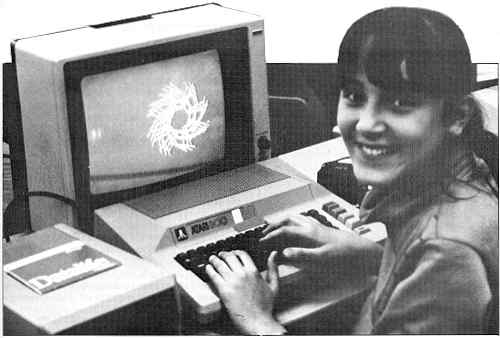
A student at Joan of Arc Junior High masters a Logo procedure.
The kids at Joan of Arc used the computer to pursue a variety of individual interests. Irving Smith, a burly fourteen-year-old, had no interest in graphics; he much preferred word games and had produced a grammar test on the parts of speech and a spelling program that requires the student to unscramble such words as "hideous," "eradicate" and "docile." Irving had decided to make programming a career.
Quite clearly the computer offered a powerful means of self-expression for Jennifer, Irving and Rafael, the author of the graffito. In varying degrees the kids treated computer work as a sociable activity in which students consulted each other for tips and pointers. Irving had been helped and inspired by an older boy the year before and seemed to enjoy teaching others; Jennifer and her friend Tenesia had more proprietary and competitive feelings about their work but were still willing to help each other with the basics.
In all, it was difficult to tell how much substance the kids had acquired from Logo programming, how much Rentof and Siegelbaum would have given them anyway and what would stay with them in later years. The kids I spoke with felt comfortable with computers and showed sensible attitudes toward technology; it would be hard to imagine them ever befuddled by future shock. If District 3's goal in establishing the Logo program was to narrow the gap between haves and have-nots, it was accomplishing its purpose.
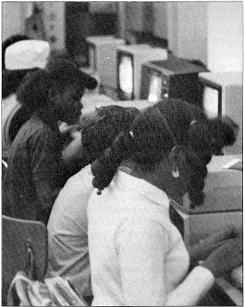
Who says computers aren't fun!

Bank Street Schoolers in computer class.
Bank Street School for Children
Students at Bank Street, a private laboratory school housed in a handsome brick building on West 112 Street, tend to be the children of teachers, psychologists and other professionals. The atmosphere here is pervaded by an aura of privilege that is cultural and psychological as well as economic.
Bank Street's reasons for installing Logo were as particular as District 3's. Psychologists at the Bank Street College of Education, which operates the school, were alarmed to see little serious research being done in the area of educational software. The college seemed a perfect place to carry on such research because, as psychologist and administrator Karen Sheingold observed, "We have a point of view about education that is seen as humanistic. At Bank Street it would not be the same as setting up research at a place deeply devoted to technology; we were likely to be helpfully critical and skeptical."
The attitude of Bank Street toward Logo is notably more reserved than that of District 3. The College certainly endorses the notion of computers in the classroom: as Sheingold says, "Here's this powerful tool that is part of kids' lives and will be more so as time goes on. For us the issue is, do you pretend it's not there or do you take it on and try to understand and guide it toward the best interests of the child?"
Like the teachers at Joan of Arc, those at Bank Street were fascinated to discover that far from being mechanical and impersonal, computer programming turned out to be a highly social affair. The children collaborated with and consulted each other much more than usual. Before, when they talked together, it was about vacation plans and basketball scores. But according to Jan Hawkins, one of the College's psychologists, "The computers appeared to provide a context where collaborative work was supported."
Hawkins' colleague, Roy Pea, had researched the question of how much children actually learn from programming and whether it helps them solve other problems. Children with a year's study were given several forty-five-minute tests. After the first, Pea found that though older and younger kids had spent roughly the same amount of time programming, the older kids understood much more; that boys had spent much more time programming and far outscored the girls; that among different kids there was a whopping twenty-five-point standard deviation from the mean score, with only three out of fifty kids at the highest level; and that "roughly one-quarter of the children in each of the classes had not become very involved in the classroom programming and did correspondingly poorly."
To see if programming skills transferred to better problem solving in life, Pea tested groups of children who'd programmed extensively in Logo for a year and groups who hadn't programmed at all, assigning a classroom chore-scheduling task to see which kids could come up with the quickest plan. Pea concluded that "on a large number of measures, the efficiency of the plans, the quality of the revisions, and the types of decisions made during the planning process, we found no differences between the progamming and nonprogramming groups, at either age."
Pea remarked that while programming advocates might protest that the test was too brief or that the effects of Logo would show up later, observation of the children and studies of other cognitive psychologists suggest that transfer of problem-solving strategies is tough even for adults to achieve, and that college students with several thousand hours of programming have trouble understanding how programs work.
The Bank Street children I talked to in the spring of 1983 seemed as "computer-literate" as the Joan of Arc kids, but quite clearly the latter group had acquired (or revised) their knowledge by working with Logo, while the Bank Street kids appeared to have gleaned much of their information from the New York Times, last night's dinner table conversation, their own and their friends' home computers.
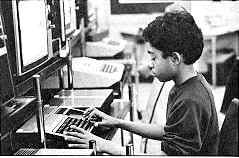
Playing the TI keyboard.
During one period in a class of eleven- and twelve-year-olds I watched six boys monopolizing the computers and soliciting each other's help from time to time, while free-floating boys stopped by and commented about what they saw on the screen. Finally the teacher wheeled one machine into another room and called for half the class to join him. Four girls went over to the machine and the teacher presented a problem that the kids worked at enthusiastically (and sometimes scrappily) together, calling out solutions and jostling each other to go next. The work on the screens didn't look as elaborate as that of the Joan of Arc kids. In the "open classroom" atmosphere of Bank Street, programming faced considerable competition from other activities.
The teacher, Michael Cook, made a point of choosing "average kids," not computer whizzes, for our discussion, and these kids talked-in an articulate and engaging manner-about frustration and boredom. "With long-term projects it seems you always fail at the end," said Simon Firestone. "Like any other toy, you get bored with it after a while. Kids get frustrated and bang down on the keys. Sometimes I start cursing and hit the keyboard."
This was the first year that Bank Street children used the computer for word processing, loading it up with the Bank Street Writer program developed at the College. Two of the three eleven-year-olds I spoke to-all described as strong writers-were full of excitement. Timo Green said, "Physically it's a lot easier than writing, and it's just 'funner.' Before I didn't want to free-write, but now when I've a chance on the computer it's different." China Parmalee said, "You see one handwritten page is half a typewritten page and you say, `I've got to write more.' "
The teacher, Kitty Newhouse, is suitably pleased; she has felt free to ask the kids for more revisions. "Now," she says, "I have conferences at the computer. We sit down with a printout of the rough draft. We're both looking at the screen and we read a sentence aloud together and they hear that they left out the comma. Last year I'd type their stories to put into the magazine, but I hadn't time to do that often. The main reason to revise your work is so it can be published-and now they can publish whenever they want."
But how soon and how far will word processing improve their product? "There's no question that for a substantial number of kids handwriting is a significant block," says Midian Kurland, who directs the Bank Street Writing Project. "Ever since the twenties, data have indicated that if you let children write at the typewriter the amount they do increases and the quality improves. But we also know from the long history of developmental research in writing that kids' major problems are organization, knowing what to write and how to frame an argument and being sensitive to their audience. None of these problems is even remotely addressed by the word processor. It's going to take much more time to see improvement."
"Our major finding," Kurland said of computer programming at Bank Street, "is that the results are highly variable. Programming does very different things for different kids. We've had kids for whom programming became a positive force in their lives, helping their self-respect and their relationship with their peers-and other kids who couldn't care less about it."
" `What is the potential of the computer?' is a meaningless question," Kurland says. "The question should be `What is the potential of the computer in a particular classroom with a particular teacher?' "
Micro Thoughts
What caused the differences in attitude and accomplishment between Joan of Are and Bank Street, and what do they suggest for the future? At Joan of Arc the kids were several years older-does their apparently greater progress tell us you can't soup up the educational philosophy of Piaget? On the other hand, their knowledge hasn't been formally tested-how profound is it?
Joan of Arc had a lab setup that enabled twenty kids to work on machines during one period, while Bank Street had six machines perpetually available to a class of twenty-five kids. Did this make a difference? At home and at school, Bank Street kids are subjected to a wealth of cultural stimuli. Did these drown Logo out, making the kids' experience with the computer less intense than that of their peers at Joan of Arc? More positively, the computer culture has been seen as a white male preserve, while at Joan of Arc it clearly isn't. Who or what gets the credit for that? Joan of Are installed computers so that poor kids wouldn't be left behind. Bank Street's mission was to study educational innovations, and its parents pay to be on the leading edge. Why should a middle-class suburban school district add programming to the curriculum?
For one such district that offers a varied programming syllabus in middle and high school, the reasons were roughly similar to Joan of Arc's: the belief that learning to handle a computer is becoming a necessary prerequisite for both jobs and college. This rationale is unquestionably true; programming will be a skill as useful as driving a car. Beyond that, however, its benefits remain unproven.
The advocates of programming will simply have to work longer and harder to convince us. Meanwhile, parents and educators should moderate their expectations, make sure that courses are thoughtfully tailored, and regard the discipline as experimental and subject to a shakedown period.
| LEARNING WITH LOGO Logo is not only a computer language, but also the foundation of an entire educational theory. Prof. Seymour Papert of M. I. T.'s Artificial Intelligence Laboratory advocates the Logo language because, he says, "children can learn to use computers in a masterful way, and learning to use computers can change the way they learn everything else." Papert's techniques, set forth in his book Mindstorms, start with the indisputable premise that programming a computer is simply a case of communicating with it in a language common to man and machine. His next premise, also indisputable, is that we absorb a foreign language far more readily when we live in its country than when we learn it by "unnatural" classroom methods. What's more, since a computer "speaks mathematics," the child will learn to speak it, too, by living in what is archly called "Mathland." Indeed, Papert lays children's mathematical difficulties on an uncongenial teaching environment and meaningless exercises. Turtle Tracks In programming with Logo, children break problems down into short procedures, which then become part of the computer's vocabulary and can later be used in other programs. As Papert and his disciples point out, theirs is the only language that encourages kids to acquire small, manageable bits of learning, then build them into hierarchies of greater knowledge. Moreover, the kids get to name their own procedures, which become special "dialects" stored on each student's disk: Breton for Jeremy, Basque for Jennifer. Logo is also interactive, which means the computer acts on an instruction the minute it's given; the child doesn't have to write a whole program before finding out if a solution works and therefore can easily experiment with different ideas. List processing is offered as well, allowing the child to organize related pieces of information into groups of varying sizes. The instrument of revelation through Logo is the Turtle, which began life as a computer-controlled cybernetic animal and in most schools is now a triangular cursor that moves about the screen at the child's command. The Turtle has two properties: position and heading. The commands FORWARD and BACK, followed by a number, move it in a straight line for a specified distance; the commands RIGHT and LEFT turn it around at a given angle. To teach the Turtle to make a square, the child simply types:
As the child progresses, the Turtle's artwork becomes increasingly elaborate: the procedure for CIRCLE, for example, becomes a part of the Turtle's vocabulary and thus a component of BALLOON, and an arrangement of balloons can be used to make a flower. 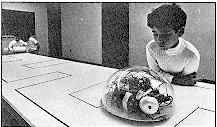 Drawing ever more elaborate pictures with Logo can embrace quite sophisticated mathematical concepts. One feature of Logo is POLYSPI, a fundamental procedure that allows the student to produce spiral designs by altering the distance or the angle at which the Turtle moves. In designing different kinds of spirals, the student should learn something about variables; further, because it produces an attractive picture, the lesson should be more. satisfying and meaningful than merely writing "x + 3" equations. Although Logo is best-known as a graphic tool for teaching kids the fundamentals of geometry and algebra, its procedural structure is also useful for verbal programs. A popular application involves learning grammar by programming a sentence structure, feeding the computer lists of nouns, verbs, adjectives, etc., and having it compose poetry at random. Most microcomputer manufacturers now offer a Logo package. The Texas Instruments computer version originated a feature called sprites, now available on other machines. Sprites come in a variety of shapes (a plane, truck, rocket, ball and box) to which the student assigns one of sixteen different colors, a heading and a speed at which they'll keep moving until told to stop. Setting several sprites moving can produce animated cartoons-and teach some physics concepts in the process. Students can also make their own sprites by filling in different tiles on a grid, a process that requires plotting with x and y coordinates. Looking Forward Papert and his team held their first extensive tryout of Logo under a National Science Foundation grant during the school year 1977-78. The entire sixth-grade class at the Lincoln School in Brookline, Massachusetts, spent between twenty and forty hours with Logo, and the work of sixteen students-chosen to represent the full range of academic abilities from above to below average-was documented in detail. Though the preliminary report centered mainly on directions for future research, one significant finding emerged. Logo instruction illuminated each child's individual style of approaching problems, a development that could help teachers and students to work together in the future. The variety of the kids' experience at the computer-and their different relationships with the machine-dramatized the importance of studying each child's emotional as well as intellectual attitudes toward learning. K.D.F. |
Return to Table of Contents | Previous Article | Next Article

